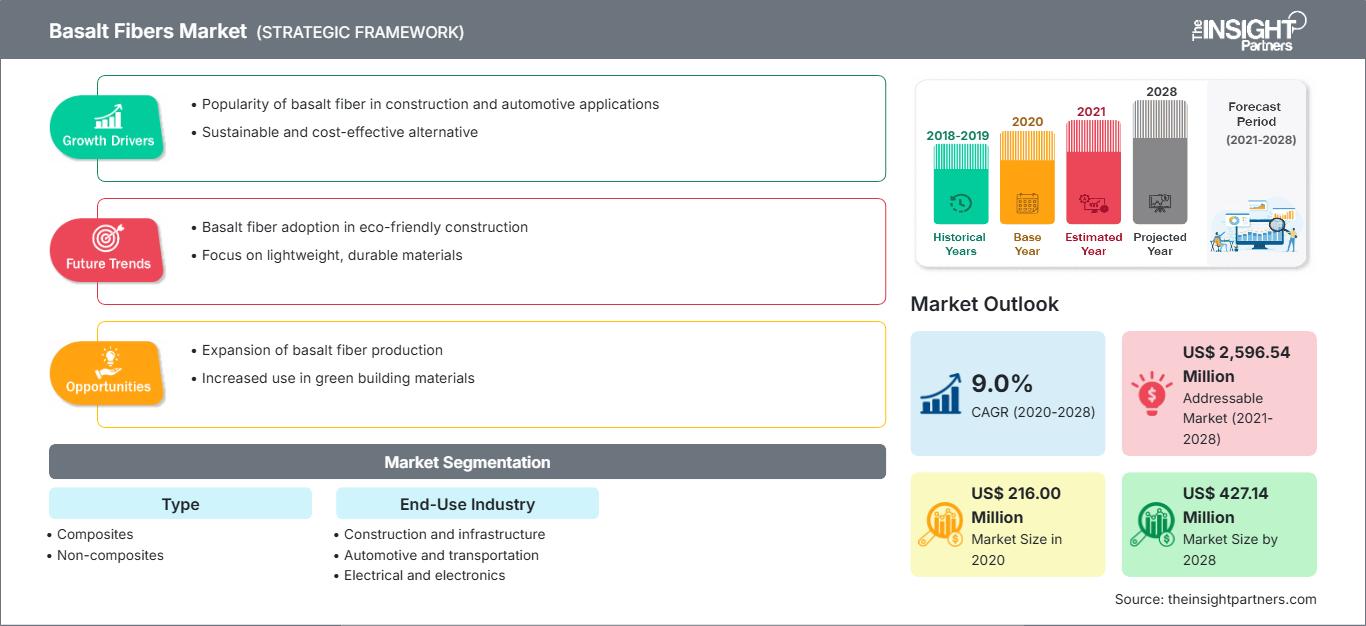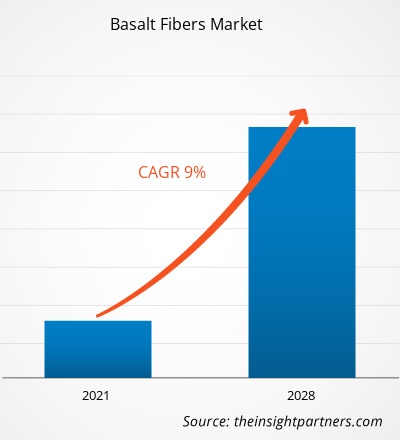현무암 섬유 시장은 2020년 2억 1,600만 달러 규모였으며, 2028년에는 4억 2,714만 달러에 이를 것으로 예상됩니다. 2021년부터 2028년까지 연평균 9.0% 성장할 것으로 예상됩니다.
현무암 섬유는 유리 섬유와 유사한 화학적 특성을 가지고 있지만, 유리 섬유보다 물리화학적 특성이 우수합니다. 자동차, 해양, 건축 및 건설, 전자 등 최종 사용 산업의 수요 증가로 현무암 섬유 시장은 높은 성장세를 보일 것으로 예상됩니다. 인구 증가, 소득 증가, 그리고 각국의 인프라 개선을 위한 정부 정책으로 인해 여러 지역에서 건설 활동이 활발해지면서 현무암 섬유 시장 성장이 가속화될 것으로 예상됩니다. 그러나 원자재의 특성 불일치는 현무암 섬유 시장 성장을 저해하는 요인 중 하나입니다. 2020년 아시아 태평양 지역은 세계 현무암 섬유 시장에서 가장 큰 비중을 차지했습니다. 아시아 태평양 지역은 인도, 중국, 일본, 한국, 호주 등 여러 개발도상국과 선진국으로 구성되어 있습니다. 신흥국들은 산업화와 도시화 활동이 급증하고 있습니다. 인도와 중국 등지의 건설 프로젝트 증가와 고속도로, 철도, 지하철 노선, 포장도로 라이닝 등 인프라 사업에 대한 투자 증가는 이 지역의 현무암 섬유 시장을 활성화할 것으로 예상됩니다.
이 보고서의 일부, 국가 수준 분석, Excel 데이터 팩을 포함하여 모든 보고서에 대한 사용자 정의를 무료로 받을 수 있을 뿐만 아니라 스타트업 및 대학을 위한 훌륭한 제안 및 할인을 이용할 수 있습니다
현무암 섬유 시장: 전략적 통찰력

-
이 보고서의 주요 주요 시장 동향을 확인하세요.이 무료 샘플에는 시장 동향부터 추정 및 예측에 이르기까지 데이터 분석이 포함됩니다.
COVID-19 팬데믹이 현무암 섬유 시장에 미치는 영향
현재 진행 중인 팬데믹은 화학 및 소재 부문의 상황을 크게 변화시켰고 현무암 섬유 시장의 성장에 부정적인 영향을 미쳤습니다.
바이러스 확산 방지 조치 시행은 여러 산업 부문의 성장에 영향을 미쳤습니다. 건설, 자동차, 화학, 전자 산업과 같은 산업은 갑작스러운 국가 및 국제 국경 폐쇄로 인한 운영 효율성의 급격한 왜곡과 가치 사슬의 붕괴로 큰 타격을 입었습니다. 여러 산업 부문의 성장이 크게 둔화되면서 세계 시장의 현무암 섬유 수요에 심각한 영향을 미쳤습니다. 그러나 각국이 운영 재개를 계획함에 따라 현무암 섬유 수요는 전 세계적으로 증가할 것으로 예상됩니다. 건설, 자동차, 화학, 전자, 항공우주 등 다양한 산업에서 현무암 섬유에 대한 수요 증가와 주요 제조업체들의 대규모 투자는 현무암 섬유 성장을 견인할 것으로 예상됩니다.시장 분석: 다양한 최종 사용 산업에서 현무암 섬유의 광범위한 적용으로 시장 성장 촉진
현무암 섬유는 건설, 자동차, 전기 및 전자, 화학, 항공우주, 해양 등 다양한 최종 사용 산업에서 광범위하게 활용됩니다. 건설 분야에서는 시멘트 패널의 균열 저항성을 높이기 위해 현무암 섬유를 절단하여 사용합니다. 극한 환경에서도 뛰어난 화학적 안정성을 유지하는 현무암 섬유는 교량, 터널, 댐, 바닥 등 다양한 콘크리트 구조물에 사용될 수 있습니다. 현무암 섬유는 화학 산업에서 내화학성 파이프, 보호 코팅, 부식성 액체 저장 탱크, 화학 비료, 산, 독성 물질 등의 생산에 사용됩니다. 현무암 섬유의 적용 분야가 확대됨에 따라 현무암 섬유에 대한 시장 수요도 빠르게 증가하고 있습니다.제품 분석
제품별로 전 세계 현무암 섬유 시장은 로빙, 초핑 스트랜드, 연사, 직물 및 테이프 등으로 구분됩니다. 로빙 부문은 2020년 전 세계 현무암 섬유 시장에서 가장 큰 점유율을 기록했습니다. 현무암 로빙은 연속적인 단방향 복합 현무암 섬유 다발입니다. 로빙은 혹독한 환경에 대한 내성, 높은 자연 강도, 긴 사용 수명, 그리고 우수한 전기 절연 특성을 가지고 있습니다. 현무암 로빙은 기술적 특성상 여러 측면에서 E-유리 및 S-유리보다 우수합니다. 현무암 로빙은 내열성이 매우 뛰어나 단시간 동안 최대 1,000°C의 온도를 견딜 수 있습니다.
Kamenny Vek Company; Fiberbas Construction and Building Technologies; Hydro Design Management Co. Pvt. Ltd.; Hg Gbf Basalt Fiber Co., Ltd; Bastech; Mafic SA; Shanxi Basalt Fiber Technology Co. Ltd; Technobasalt-Invest LLC; Deutsche Basalt Faser Gmbh; 및 Basalt Engineering LLC는 글로벌 현무암 섬유 시장에서 운영되는 주요 기업 중 하나입니다.
보고서 스포트라이트
- 현무암 섬유 시장의 진보적인 산업 동향은 플레이어가 효과적인 장기 전략을 개발하는 데 도움이 됩니다.
- 선진국 및 개발도상국 시장에서 채택한 사업 성장 전략
- 2019년부터 2028년까지 현무암 섬유 시장에 대한 정량적 분석
- 현무암 섬유에 대한 글로벌 수요 추정
- 산업에서 운영되는 구매자와 공급자의 효율성을 보여주기 위한 PEST 분석
- 경쟁적인 시장 시나리오를 이해하기 위한 최근 개발
- 현무암 섬유 시장 성장을 주도하고 제한하는 요인과 더불어 시장 동향 및 전망
- 상업적 관심을 뒷받침하고 시장 성장을 이끄는 시장 전략을 강조하여 의사 결정 프로세스 지원
- 규모 다양한 노드에서의 현무암 섬유 시장 규모
- 시장의 세부적인 개요 및 세분화, 현무암 섬유 산업 역학
- 성장 기회가 유망한 다양한 지역의 현무암 섬유 시장 규모
현무암 섬유 시장 지역별 통찰력
The Insight Partners의 분석가들은 예측 기간 동안 현무암 섬유 시장에 영향을 미치는 지역별 동향과 요인들을 면밀히 분석했습니다. 이 섹션에서는 북미, 유럽, 아시아 태평양, 중동 및 아프리카, 그리고 중남미 지역의 현무암 섬유 시장 부문 및 지역별 현황도 다룹니다.
현무암 섬유 시장 보고서 범위
| 보고서 속성 | 세부 |
|---|---|
| 시장 규모 2020 | US$ 216.00 Million |
| 시장규모별 2028 | US$ 427.14 Million |
| 글로벌 CAGR (2020 - 2028) | 9.0% |
| 이전 데이터 | 2018-2019 |
| 예측 기간 | 2021-2028 |
| 다루는 세그먼트 |
By 유형
|
| 포함된 지역 및 국가 |
북미
|
| 시장 선도 기업 및 주요 회사 프로필 |
|
현무암 섬유 시장 참여자 밀도: 비즈니스 역학에 미치는 영향 이해
현무암 섬유 시장은 소비자 선호도 변화, 기술 발전, 그리고 제품의 효능에 대한 인식 제고 등의 요인으로 인한 최종 사용자 수요 증가에 힘입어 빠르게 성장하고 있습니다. 수요가 증가함에 따라 기업들은 제품 라인업을 확장하고, 소비자 니즈를 충족하기 위한 혁신을 추진하며, 새로운 트렌드를 적극 활용하고 있으며, 이는 시장 성장을 더욱 가속화하고 있습니다.

- 을 얻으세요 현무암 섬유 시장 주요 주요 플레이어 개요
글로벌 현무암 섬유 시장
제품별
- 로빙
- 촙 스트랜드
- 연사
- 직물 및 테이프
- 기타
최종 사용 산업별
- 건설
- 자동차
- 전기 및 전자
- 화학
- 기타
회사 프로필
- Kamenny Vek Company
- Fiberbas 건설 및 건축 기술
- Hydro Design Management Co. Pvt. Ltd.
- Hg Gbf Basalt Fiber Co., Ltd.
- Bastech
- Mafic SA
- Shanxi Basalt Fiber Technology Co. Ltd.
- Technobasalt-Invest LLC
- Deutsche Basalt Faser Gmbh
- Basalt Engineering LLC
- 과거 분석(2년), 기준 연도, CAGR을 포함한 예측(7년)
- PEST 및 SWOT 분석
- 시장 규모 가치/거래량 - 글로벌, 지역, 국가
- 산업 및 경쟁 환경
- Excel 데이터세트
최근 보고서
관련 보고서
사용 후기
구매 이유
- 정보에 기반한 의사 결정
- 시장 역학 이해
- 경쟁 분석
- 고객 인사이트
- 시장 예측
- 위험 완화
- 전략 기획
- 투자 타당성 분석
- 신흥 시장 파악
- 마케팅 전략 강화
- 운영 효율성 향상
- 규제 동향에 발맞춰 대응






















 무료 샘플 받기 - 현무암 섬유 시장
무료 샘플 받기 - 현무암 섬유 시장